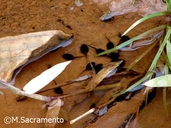|
Rhinella pombali (Baldiserra, Caramaschi and Haddad, 2004)
sapo-cururu, sapo-amarelo | family: Bufonidae genus: Rhinella |
| Species Description: Baldisera,Caramaschi & Haddad,2004 Arquivos do Museu Nacional,Rio de Janeiro 62(3): 255-282 | |
 © 2009 Mario Sacramento (1 of 5) |
|
|
|
Description The color in life varies, but almost all the specimens display a brown or whitish dorsal stripe, from the tip of the head to the cloaca. The dorsal surface is granulated, and its color varies from dark to light brown, and reddish in life. Dark gray stripes on limbs, varying from complete to a faint pattern. A yellow blotch (whitish in preserved specimens) appears on the posterior surface of the thighs, and yellow marks near the cloaca (Baldissera Jr. et al. 2004). Distribution and Habitat Country distribution from AmphibiaWeb's database: Brazil
The species is distributed along the Atlantic Rain Forest and in its transitional areas with the Cerrado, in the Minas Gerais State, Brazil. It is found from 700-1,500 m above sea level. Bufo pombali lives on leaf litter inside woodlands, under rocks near small rivulets when resting (pers. obs.) and in open areas, such as grasslands and rice fields with Poaceae and Cyperaceae (Baldissera Jr, et al. 2004). Life History, Abundance, Activity, and Special Behaviors The general population biology is unknown but the species is locally abundant throughout its range (Feio et al. 1998; Feio and Ferreira 2005; pers. obs.). Abundance increases between September and March (Sacramento 2004). Larva Eterovick (2000) carried out field experiments on the feeding ecology of B. pombali tadpoles and pointed out that there was a difference in the number and volume of food items eaten by aggregated vs. isolated tadpoles. This result was mainly related to the amount of cyanophytes and heterotrophic organisms, which can result in differences in growth rate; aggregated tadpoles may thus have some advantage in food ingestion (Eterovick 2000). Trends and Threats Bufo pombali can apparently withstand some habitat modification, and seems to be able to live even in areas near man-made facilities (pers. obs.). Possible reasons for amphibian decline General habitat alteration and loss Comments For additional resources, see: Pereyra, M. O., B. L. Blotto, D. Baldo, J. C. Chaparro, S. R. Ron, A. J. Elias-Costa, P. P. Iglesias, P. J. Venegas, M. T. C. Thomé, J. J. Ospina-Sarria, N. M. Maciel, M. Rada, F. Kolenc, C. Borteiro, M. Rivera-Correa, F. J. M. Rojas-Runjaic, J. Moravec, I. De la Riva, W. C. Wheeler, S. Castroviejo-Fisher, T. Grant, C. F. B. Haddad, and J. Faivovich. 2021. Evolution in the genus Rhinella: A total evidence phylogenetic analysis of Neotropical True Toads (Anura: Bufonidae). Bulletin of the American Museum of Natural History 447: 1–156 [link] Thomé, M.T.C., et al. 2010. Phylogeography of endemic toads and Post-Pliocene persistence of the Brazilian Atlantic Forest. Molecular Phylogenetics and Evolution 55: 1018–1031. [link] Thomé, M.T.C., K.R. Zamudio, C.F.B. Haddad, and J. Alexandrino. 2012. Delimiting genetic units in Neotropical toads under incomplete lineage sorting and hybridization. BMC Evolutionary Biology 12: 242. [link]
References
Baldissera Jr, F. A., Caramaschi, U. and Haddad, C.F.B. (2004). ''Review of the Bufo crucifer species group, with descriptions of two new related species (Amphibia, Anura, Bufonidae).'' Arquivos do Museu Nacional, 62, 255-282. Eterovick, P. C. (2000). ''Effects of aggregation on feeding of Bufo crucifer tadpoles (Anura, Bufonidae).'' Copeia, 2000, 210-215. Eterovick, P. C., and Barata, I. M. (2006). ''Distribution of tadpoles within and among Brazilian streams: the influence of predators, habitat size and heterogeneity.'' Herpetologica, 62, 365-377. Feio, R. N. (1990). Aspectos ecológicos dos anfibios registrados no Parque Estadual do Ibitipoca, MG. (Amphibia, Anura). Master's Thesis, UFRJ-MN, Rio de Janeiro. Feio, R. N., Braga, U. M. L., Wiederhecker, H., and Santos, P. S. (1998). Anfíbios do Parque Estadual do Rio Doce (Minas Gerais). The Universidade Federal de Viçosa Press and Instituto Estadual de Florestas, Viçosa-MG, Brazil. Feio, R. N., and Ferreira, P. L. (2005). ''Anfíbios de dois fragmentos de Mata Atlântica no municipio de Rio Novo, Minas Gerais.'' Revista Brasileira de Zoociências, 7, 121-128. Frost, D. R. (2007). Amphibian Species of the World: an Online Reference. Version 5.1 (10 October 2007). Electronic Database accessible at http://research.amnh.org/herpetology/amphibia/index.php. American Museum of Natural History, New York, USA. Sacramento, M. A. (2004). Análise da Diversidade de Anfíbios do Parque Estadual Nova Baden, Lambari-MG. Research Report, UNIFAL-MG, Alfenas-MG, Brazil. Originally submitted by: Diogo Borges Provete and Mario Antonio Sacramento (first posted 2008-07-30) Comments by: Ann T. Chang (updated 2024-02-20)
Edited by: Kellie Whittaker, Michelle S. Koo (2024-02-20) Species Account Citation: AmphibiaWeb 2024 Rhinella pombali: sapo-cururu <https://amphibiaweb.org/species/6616> University of California, Berkeley, CA, USA. Accessed May 29, 2025.
Feedback or comments about this page.
Citation: AmphibiaWeb. 2025. <https://amphibiaweb.org> University of California, Berkeley, CA, USA. Accessed 29 May 2025. AmphibiaWeb's policy on data use. |


 Map of Life
Map of Life